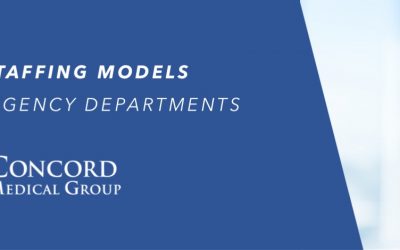There’s no question that an emergency department can be a busy, hectic environment that can place incredible stress on physicians, nurses and – of course – the patients under their care. When an ED is overcrowded and understaffed, you can kick the stress up another notch.
But overcrowding creates more than just a heightened stressful environment. Research suggests that the Institute of Medicine’s six dimensions of quality – safety, effectiveness, patient-centeredness, efficiency, timeliness, and equity – may all be compromised when EDs are overcrowded, and patients must endure long wait times.
In short, patient flow and medical staffing work hand in hand. An ED with staffing problems and patient flow issues that often accompany them take on a lot of risks, including the risk that patients will walk out on them and seek care elsewhere. In other cases, ambulances are diverted to other hospitals (from ones that are closest to the patient). And, even more seriously, there are heightened opportunities for error when ED capacity is exceeded.
Improving patient flow
Patient flow is at the foundation of overcrowding issues in emergency departments. Studies show that increasing patient flow while decreasing wait time in the ED and throughout the hospital is a highly-effective way to address overcrowding issues. Hospitals are encouraged to form patient flow teams – made up of a multi-disciplinary group of physicians, nurses, and support staff – to develop quality improvement plans. For example, patient flow teams can:
- Identify specific problems: Identifying possible roadblocks to patient flow in the ED is vital. Are slow lab turnaround times contributing to the problem? Are patients waiting an especially long time for a physician specialist consult? Are subspecialists – such as an orthopedic surgeon or endocrinologist – seeing patients promptly? For example, one hospital’s patient flow improvement team implemented a strategy to speed up subspecialist requests by establishing a specific time frame in which consulting physicians were expected to respond to the request.
- Appraise resources: Hospitals need to continually monitor whether their staff resources meet the daily demands of their ED department. Research shows that lower staff levels are associated with a greater risk of poor patient outcomes. Additionally, ED crowding and poor patient flow compromise community trust. An ED plays an important role in the community, and the public expectation is that it will provide timely care at any time of the day or night.
How Concord helps
The Concord Medical Group is there for you when your ED is overwhelmed. CMG provides weekend, part-time, or full-time coverage to fill the gaps in your scheduling – and to keep your department’s patient flow running at optimal levels. Concord has an extensive network of physicians who are looking for new opportunities now.
Concord also provides consulting and management services that will design a plan to fit your unique talent base.
More Posts
Empowering the Rural ED: Unlock Excellence in Your Emergency Department
Managing a rural ED is a complex challenge that requires strategy, innovation, and a relentless focus on both people and outcomes. For hospital executives and clinical leaders, success hinges on the ability to balance high-quality care, operational efficiency, and staff satisfaction. Here are some essential strategies to help you unlock excellence in your ED.
Concord Announces Dr. John Jones as Chief Medical Officer of Emergency Medicine
Concord Medical Group is extremely excited to announce that John Jones, MD has accepted the role of Chief Medical Officer of Emergency Medicine.
Creative Staffing Models for Rural Emergency Departments
Staffing an emergency department with the right providers is essential to deliver high quality care and keep costs under control. We have found that creative and custom staffing models are essential to driving care quality and boosting financial health in rural, low-volume emergency departments.






